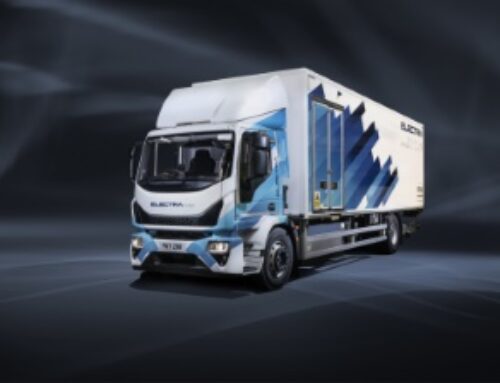Talking TPMS with Haldex
 Trailer technology provider Haldex has provided detailed insight into the workings of its tyre pressure monitoring system (TPMS).
Trailer technology provider Haldex has provided detailed insight into the workings of its tyre pressure monitoring system (TPMS).
The company has offered a technical solution for commercial vehicle trailer axles for more than a decade. The Haldex TPMS system comprises two parts: a battery-powered wheel rim-mounted sensor (or sensors), and a receiver control unit (RCU) to which they communicate, and which in turn communicates with the Haldex EBS.
The system is compatible with Haldex Gen 2 braking systems as well as EB+4.0, though not competitors’ systems. It can be fitted to any wheel on the trailer.
Although the primary benefit of such systems is to prevent a blowout by measuring pressure, in so doing, they provide an even more useful efficiency function, according to Haldex trailer products specialist Andre Wilt.
Underinflated tyres bulge at the bottom (a phenomenon known as tyre hysteresis). As the tyre rotates, the bulge moves around the sidewall – or rather the sidewall moves around the bulge, forcing it to move in and out. That flexion heats up the tyre, and the air caught inside the tyre.
In an extreme case, this warming effect is so great that it rapidly ramps up the pressure until the tyre explodes. But even in borderline cases, the additional rolling resistance consumes energy, adding to the tyre’s rolling resistance and hence consuming extra fuel. As it also tends to wear out the tyre, detecting the issue early can save money later on.
The Haldex TPMS system measures not only pressure but temperature. As a result, the system may pick up other system faults, such as a locked brake (disc or drum) or a bearing fault, both of which would conduct heat through the axle metal to the wheel rim.
The trick, says the firm, is appreciating the difference between a normal and abnormal elevated temperature.
Explained Andre Wilt: “Our experience provides limits to the system, and alerts are raised if the temperature crosses limits. For example, if rim temperatures exceed 60°, that’s the alarm limit. Below that is seen to be operational. Over 60° risks melting grease in the hub, and that will cause additional problems.”
It’s the same with pressure: TPMS systems warn users when pressures drop below a certain threshold: as standard on the Haldex-supplied system, that is, 15 per cent of nominal (8bar on a 9bar nominal, for example), a figure based on tyre manufacturer data.
Such a range is large enough not to flag up the oscillation in tyre pressures caused by loading cycles. A second lower limit (6 or 7bar in the above example) indicates extreme underpressure. Haldex allows users to reconfigure the limits to suit their operations’ parameters.
 By design, the system can capture both slow leaks and punctures. The former will eventually reach a limit and trigger an alarm. But punctures trigger in a different way. In normal functioning, the system sends a temperature and pressure reading every two minutes.
By design, the system can capture both slow leaks and punctures. The former will eventually reach a limit and trigger an alarm. But punctures trigger in a different way. In normal functioning, the system sends a temperature and pressure reading every two minutes.
If during that interval the sensor detects a significant pressure drop relative to the previous reading, it sends an additional value to the receiver, which flags it as a leak and sends a warning immediately – even if the reading is still within normal operational margins. This provides the earliest possible warning of a puncture, which in an extreme case could empty a tyre in less than a minute.
When actuated, the TPMS system sends an alert to a dash-mounted warning light, to indicate that the driver should stop and check the wheels. Signals are also sent via the vehicle’s telematics system, if installed, to the operator’s central fleet management platform.
As the dash light can only indicate the presence of a problem, not where the problem is, after stopping the driver must either check every tyre. But the system knows. When the sensor codes are entered during initial system configuration, Haldex’s Diag+ system will pinpoint the location of a fault, or a low battery signal, for example. (Users with Diag+ and a dongle connection to the truck can reassign wheel positions if the tyres are rotated.)
To provide extra detail, an optional trailer side-mounted Haldex Info Centre system reads fault codes – including individual tyre issues – through digital connection to the EBS. Technicians navigate via a digital LCD screen display. Technicians can use the same system to reassign wheel positions when rotating tyres.
Such a system works fine when the trailer is connected to the tractor and fed with power, says Haldex, but it also has a solution to enable problems to be identified on trailers that have been decoupled, in the form of Info Point.
It consists of a connection to the TPMS signal line and a trailer-mounted display unit incorporating a turning cam. When triggered, the cam turns a bicoloured black/red indicator ball so the red side shows to the exterior, indicating a problem even when the vehicle system is powered down.
For older vehicles without a dash light, Haldex can fit one or two side-mounted warning lights to indicate the existence of a problem.
Operators interested in exploring the economics of TPMS fitment can access a free online calculator available via the website. It uses standard tyre industry figures to estimate the return on investment of TPMS installation.










